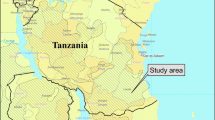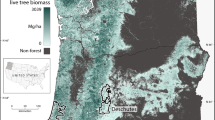Abstract
We investigated a strategy to improve predicting capacity of plot-scale above-ground biomass (AGB) by fusion of LiDAR and Landsat5 TM derived biophysical variables for subtropical rainforest and eucalypts dominated forest in topographically complex landscapes in North-eastern Australia. Investigation was carried out in two study areas separately and in combination. From each plot of both study areas, LiDAR derived structural parameters of vegetation and reflectance of all Landsat bands, vegetation indices were employed. The regression analysis was carried out separately for LiDAR and Landsat derived variables individually and in combination. Strong relationships were found with LiDAR alone for eucalypts dominated forest and combined sites compared to the accuracy of AGB estimates by Landsat data. Fusing LiDAR with Landsat5 TM derived variables increased overall performance for the eucalypt forest and combined sites data by describing extra variation (3% for eucalypt forest and 2% combined sites) of field estimated plot-scale above-ground biomass. In contrast, separate LiDAR and imagery data, and fusion of LiDAR and Landsat data performed poorly across structurally complex closed canopy subtropical rainforest. These findings reinforced that obtaining accurate estimates of above ground biomass using remotely sensed data is a function of the complexity of horizontal and vertical structural diversity of vegetation.
Similar content being viewed by others
References
Armston JD, Denham RJ, Danaher TJ, Scarth PF, Moffiet TN. 2009. Prediction and validation of foliage projective cover from Landsat-5 TM and Landsat-7 ETM+ imagery. Journal of Applied Remote Sensing, 3: 1–28.
Birth GS, McVey G. 1968. Measuring the colour of growing turf with a reflectance spectrophotometer. Agronomy Journal, 60: 640–643.
Bortolot ZJ, Wynne RH. 2005. Estimating forest biomass using small footprint LiDAR data: An individual tree-based approach that incorporates training data. Isprs Journal of Photogrammetry and Remote Sensing, 59: 342–360.
Brown L, Chen JM, Leblanc SG, Cihlar J. 2000. A shortwave infrared modification to the simple ratio for LAI retrival in borel forests: and image and model analysis. Remote Sensing of Environment, 71: 16–25.
Bureau of Meterology. 2010. Bureau of Meteorology (ABN 92 637 533 532), Australia. Available at: http://www.bom.gov.au [accessed on 2 August 2012].
Chambers JQ, dos Santos J, Ribeiro RJ, Higuchi N. 2001. Tree damage, allometric relationships, and above-ground net primary production in central Amazon forest. Forest Ecology and Management, 152: 73–84.
Chave JH, Andalo C, Brown S, Cairns MA, Chabbers JQ, Eamus D, Folster H, Fromard F, Higuchi N, Kira T, Lescure JP, Nelson BW, Ogawa H, Puig H, Riera B, Yamakura T. 2005. Tree allometry and improved estimation of carbon stocks and balance in tropical forests. Oecologia, 145: 87–99.
Chen JM. 1996. Evaluation for vegetation indices and modified simple ration for boreal application Canadian Journal of Remote Sensing, 22: 229–242.
Drake JB, Dubayah RO, Knox RG, Clark DB, Blair JB. 2002. Sensitivity of large-footprint LiDAR to canopy structure and biomass in a neotropical rainforest. Remote Sensing of Environment, 81: 378–392.
Drake JB, Knox RG, Dubayah RO, Clark DB, Condit R, Blair JB, Hofton M. 2003. Above-ground biomass estimation in closed canopy Neotropical forests using lidar remote sensing: factors affecting the generality of relationships. Global Ecology and Biogeography, 12: 147–159.
Ediriweera S, Pathirana S, Danaher T, Nichols D. 2014 (accepted). LiDAR remote sensing of structural properties of subtropical rainforest and eucalypt forest in complex terrain in North-eastern Australia. Journal of Tropical Forest Science.
Erdody TL, Moskal LM. 2010. Fusion of LiDAR and imagery for estimating forest canopy fuels. Remote Sensing of Environment, 114: 725–737.
Fassnacht KS, Gower ST. 1997. Interrelationships between the edaphic and stand characteristics, leaf area index and above ground next primary productivity of upland forest ecosystems in north central Wisconsin. Canadian Journal of Forestry, 27: 1058–1067.
Flood N, Danaher T, Gill T, Gillingham S. 2013. An Operational Scheme for Deriving Standardised Surface Reflectance from Landsat TM/ETM+ and SPOT HRG Imagery for Eastern Australia. Remote Sensing, 5: 83–109.
Florence RG. 1996 Ecology and Silviculture of Eucalypt Forests. CSIRO Australia.
Foody GM, Boyd DS, Cutler MEJ. 2003. Predictive relations of tropical forest biomass from Landsat TM data and their transferability between regions. Remote Sensing of Environment, 85: 463–474.
Foody GM, Cutler ME, McMorrow J, Pelz D, Tangki H, Boyd DS, Douglas I. 2001. Mapping the biomass of Bornean tropical rain forest from remotely sensed data. Global Ecology and Biogeography, 10: 379–387.
Franklin J. 1986. Thematic mapper analysis of coniferous forest structure and composition. International Journal of Remote Sensing, 7: 1287–1301.
Heurich M, Thoma F. 2008. Estimation of forestry stand parameters using laser scanning data in temperate, structurally rich natural European beech (Fagus sylvatica) and Norway spruce (Picea abies) forests. Forestry, 81: 645–661.
Hudak AT, Crookston NL, Evans JS, Falkowski MJ, Smith AMS, Gessler PE, Morgan P. 2006. Regression modelling and mapping of coniferous forest basal area and tree density from discrete-return LiDAR and multispectral satellite data. Canadian Journal of Remote Sensing, 32: 126–138.
Hudak AT, Lefsky MA, Cohen WB. 2001: Integration of lidar and Landsat ETM data. In: Hofton, M.A. (ed.), The international archives of the Photogrammetry, Remote Sensing and Spatial Information Science. Volume XXXIV, Part 3/W4, Commission III, Annapolis MD, 22–24 October, pp.95–104
Jakubauskas ME, Price KP. 1997. Empirical relationaship between structural and spectral factors of Yellowstone Lodgepole Pine Forests. Photogrammetric Engineering & Remote Sensing, 63: 1375–1381.
Jensen JLR, Humes SK, Vierling LA, Hudak AT. 2008. Discrete return LiDAR based prediction of leaf area index in two conifer forests. Remote Sensing of Environment, 112: 3947–3957.
Krasnow K, Schoennagel T, Veblen TT. 2009. Forest fuel mapping and evaluation of LANDFIRE fuel maps in Boulder country, Colorado, USA. Forest Ecology and Management, 257: 1603–1612.
Latifi H, Nothdurft A, Koch B. 2010. Non-parametric prediction and mapping of standing timber volum and biomass in a temperature forest. Application of multiple optical/LiDAR-derived predictors. Forestry, 83: 395–407.
Li Y, Andersen HE, McGaughey R. 2008. A comparison of statistical methods for estimating forest biomass from light detection and ranging data. Western Journal of Applied Forestry, 23: 223–231.
Lovell JL, Jupp DLB, Culvenor DS, Coops NC. 2003. Using airborne and ground-based ranging lidar to measure canopy structure in Australian forests. Canadian Journal of Remote Sensing, 29: 607–622.
Lu D. 2006. The potential and challenge of remote sensing based biomass estimation. International Journal of Remote Sensing, 27: 1297–1328.
Lu D, Batistella M. 2005. Exploring TM image texture and its relationships with biomass estimation in Rondonia, Brazilian Amazon. Acta Amazonica, 35: 261–268.
Lu D, Chen Q, Wang G, Moran E, Batistella M, Zhang M, Vaglio LG, Saah D. 2012. Aboveground Forest Biomass Estimation with Landsat and LiDAR Data and Uncertainty Analysis of the Estimates. International Journal of Forestry Research, 2012: 16.
Lymburner L, Beggs PJ, Jacobson CR. 2000. Estimation of canopy-average surface-specific leaf area using Landsat TM data. Photogrammetric Engineering and Remote Sensing, 66: 183–191.
Markham BL, Helder DL. 2012. Forty-year calibrated record of earth-reflected radiance from Landsat: A review. Remote Sensing of Environment, 122 30–40.
McCombs JW, Roberts SD, Evans DL. 2003. Influence of fusing LiDAR and multispectral imagery on remotely sensed estimates of stand density and mean tree height in managed Loblolly pine plantation. Forest Science, 49: 457–466.
Moffiet T, Armston JD, Mengersen K. 2010. Motivation, development and validation of a new spectral greenness index: A spectral dimension related to foliage projective cover. Isprs Journal of Photogrammetry and Remote Sensing, 65: 26–41.
Mutlu M, Popescu SC, Stripling C, Spencer T. 2008. Mapping surface fuel models using lidar and multispectral data fusion for fire behavior. Remote Sensing of Environment, 112: 274–285.
Myneni RB, Williams DL. 1994. On the Relationship between FAPAR and NDVI. Remote Sensing of Environment, 49: 200–211.
Nemani R, Pierce L, Running S, Band L. 1993. Forest ecosystem processes at the watershed scale: sensitivity to remotely-sensed Leaf Area Index estimates. International Journal of Remote Sensing, 14: 2519–2534.
Patenaude G, Milne R, Dawson TP. 2005. Synthesis of remote sensing approaches for forest carbon estimation: reporting to the Kyoto Protocol. Environmental Science and Policy, 8: 161–178.
Popescu SC. 2007. Estimating biomass of individual pine trees using airborne LiDAR. Biomass and Bioenergy, 31: 646–655.
Popescu SC, Wynne RH, Nelson RF. 2003. Measuring individual tree crown diameter with LiDAR and assessing its influence on estimating forest volume and biomass. Canadian Journal of Remote Sensing, 29: 564–577.
Popescu SC, Wynne RH, Scrivani JA. 2004. Fusion of Small-Footprint Lidar and Multispectral Data to Estimate Plot-Level Volume and Biomass in Deciduous and Pine Forests in Virginia, USA. Forest Science, 50: 551–565.
Reich PB, Walters MB, Ellsworth DS. 1997. From tropic to tundra: Global convergence in plant functioning. In: Proceeding of the National Academy of Sciences, pp. 13730–13734, USA.
Reich PB, Walters MB, Ellsworth DS, Vose JM, Volin JC, Gresham C, Bowman WD. 1988. Relationships of leaf dark respiration and leaf area index to specific leaf area and leaf life -span: A test across biomes and functional group Oecologia, 114: 471–482.
Riggins JJ, Tullis JA, Stephen FM. 2009. Per-segment Aboveground Forest Biomass Estimation Using LIDAR-Derived Height Percentile Statistics. Gioscience & Remote Sensing, 46: 232–248.
Rouse JW, Haas RH, Schell JA, Deering DW. 1974. Monitoring vegetation systems in the Great Plains with ERTS. In: Third Earth Resources Technology Satellite-1 Symposium. NASA SP-351, Greenbelt, Md., Woshington DC. pp. 301–317.
Roy PS, Ravan SA. 1996. Biomass estimation using satellite remote sensing data-an investigation on possible approaches for natural forest. Journal of Biosciencce, 21: 535–561.
Smith RGB, Nichols JD, Vanclay JK. 2005. Dynamics of tree diversity in undisturbed and logged subtropcal rainforest in Australia. Biodiversity and Conservation, 14: 2447–2463.
Spanner MA, Pierce LL, Peterson DL, Running SW. 1990. Remote sensing of temperate coniferous forest leaf area index The influence of canopy closure, understory vegetation and background reflectance. International Journal of Remote Sensing, 11: 95–111.
Specht A, West PW. 2003. Estimation of biomass and sequestered carbon on farm forest plantations in northern New South Wales Australia. Biomass Bioenergy, 25: 363–379.
Specht RL, Specht A. 1999 Australian plant communities: dynamics of structure, growth and biodiversity.Oxford University Press.
Tonolli S, Dalponte M, Neteler M, Rodeghiero M, Vescovo L, Gianelle D. 2011. Fusion of airborne LiDAR and satellite multispectral data for the estimation of timber volume in the Southern Alps. Remote Sensing of Environment, 115: 2486–2498.
Treitz PM, Howarth PJ. 1999. Hyperspectral remote sensing for estimating biophysical parameters of forest ecosystems. Progress in Physical Geography, 23: 359–390.
Vermote FE, Tanre D, Deuze JL, Herman M, Morcrette JJ. 1997. Second Simulation of the Satellite Signal in the Solar Spectrum, 6S: Overview. Ieee Transactions on Geoscience and Remote Sensing, 35: 675–686.
Vogelmann JE. 1990. Comparison between two vegetation indices for measuring different types of forest damage in the northeastern United States. International Journal of Remote Sensing, 11: 2281–2297.
Weller D, Denham R, Witte C, Mackie C, Smith D. 2003. Assessment and monitoring of foliage projected cover and canopy height across native vegetation in Queensland, Australia, using laser profiler data. Canadian Journal of Remote Sensing, 29: 578–591.
Westman WE, Rogers RW. 1977. Biomass and structure of a subtropical eucalypt forest, North Stradbroke Island. Australian Journal of Botany, 25: 171–19.
Zheng D, Rademacher J, Chen J, Crow T, Bresee M, Le Moine J, Ryu SR. 2004. Estimating aboveground biomass using Landsat 7 ETM+ data across a managed landscape in northern Wisconsin, USA. Remote Sensing of Environment, 93: 402–411.
Zianis D, Mencuccini M. 2004. On simplifying allometric analyses of forest biomass. Forest Ecology and Management, 187: 311–332.
Author information
Authors and Affiliations
Corresponding author
Additional information
Project funding: This study was made possible by a scholarship from the Australian Government (International Postgraduate Research Scholarship-awarded in 2009) and a Southern Cross University Postgraduate Research Scholarship (SCUPRS in 2009)
Rights and permissions
About this article
Cite this article
Ediriweera, S., Pathirana, S., Danaher, T. et al. Estimating above-ground biomass by fusion of LiDAR and multispectral data in subtropical woody plant communities in topographically complex terrain in North-eastern Australia. Journal of Forestry Research 25, 761–771 (2014). https://doi.org/10.1007/s11676-014-0485-7
Received:
Accepted:
Published:
Issue Date:
DOI: https://doi.org/10.1007/s11676-014-0485-7




